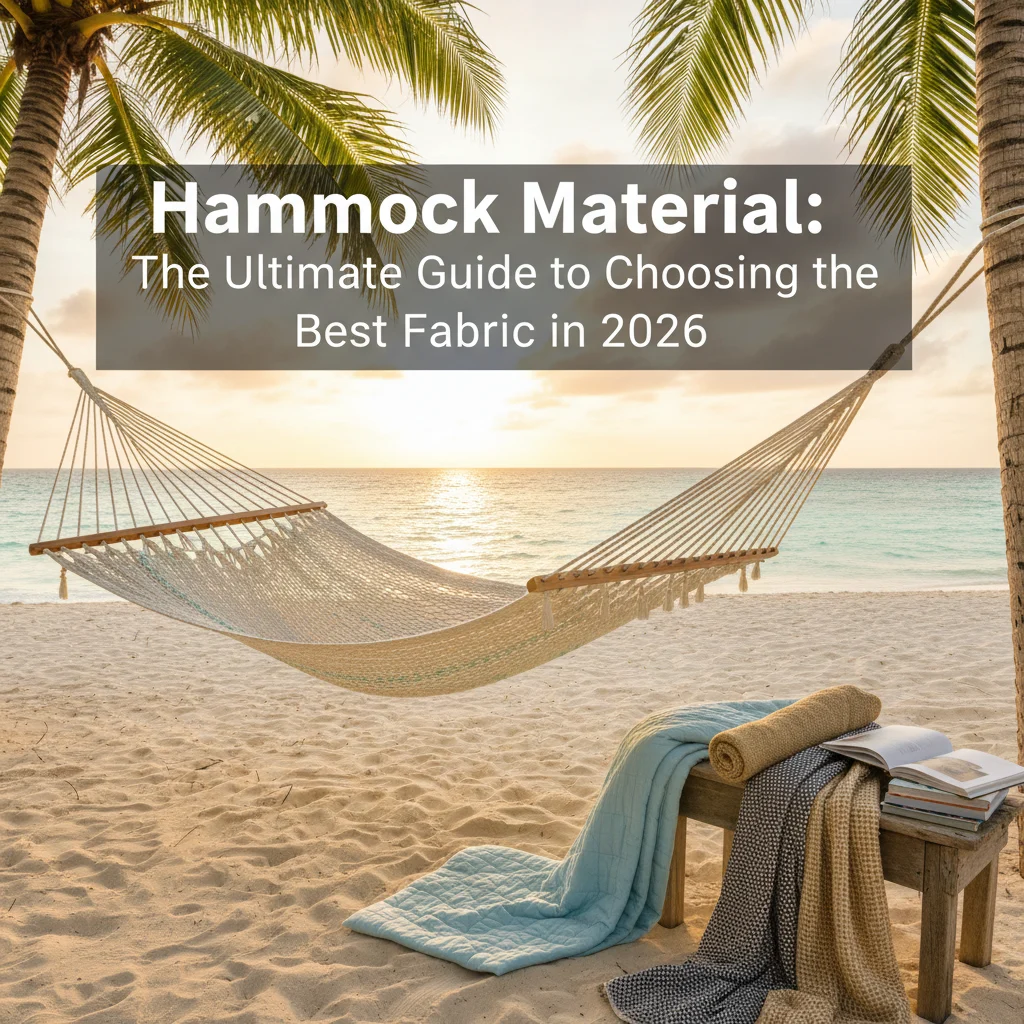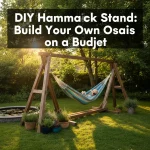[Get the best value hammock material on Amazon today!]
# Hammock Material: The Ultimate Guide to Choosing the Best Fabric in 2026
Choosing the right hammock material can be the difference between a relaxing afternoon swaying in the breeze and a sweaty, uncomfortable experience. With so many options available, from traditional cotton to high-tech synthetics, it’s easy to feel overwhelmed. But don’t worry! This ultimate guide will break down everything you need to know to choose the best hammock material for your needs in 2026. We’ll cover the pros and cons of each type, consider factors like durability, comfort, and weather resistance, and help you find the perfect hammock for your outdoor (or indoor!) oasis.
[Browse top-rated hammock material on Amazon]
## Understanding Hammock Material: Why It Matters
The material of your hammock significantly impacts its comfort, durability, and overall lifespan. Think about it: you’re trusting this fabric to support your weight, withstand the elements, and provide a comfortable place to relax. A poor choice can lead to premature wear and tear, discomfort, and even safety hazards.
Here’s a breakdown of why choosing the right hammock material is so important:
* **Comfort:** Different materials offer varying levels of softness, breathability, and stretch. Some are perfect for hot weather, while others provide warmth on cooler days.
* **Durability:** The material’s resistance to tearing, fading, and mildew determines how long your hammock will last.
* **Weather Resistance:** If you plan to leave your hammock outdoors, you need a material that can withstand sun, rain, and wind.
* **Weight Capacity:** Different materials have different weight limits. Make sure to choose one that can safely support your weight.
* **Maintenance:** Some materials are easier to clean and care for than others.
Choosing the right hammock material is an investment in your relaxation and enjoyment. Let’s dive into the different options available.
[Browse top-rated hammock material on Amazon]
## Popular Hammock Materials: Pros and Cons
Here’s a comprehensive overview of the most common hammock materials, along with their advantages and disadvantages.
### Cotton
Cotton is a classic choice for hammocks, known for its softness and comfort.
**Pros:**
* **Comfort:** Cotton is incredibly soft and feels great against the skin.
* **Breathability:** It allows air to circulate, keeping you cool on warm days.
* **Affordability:** Cotton hammocks are generally more affordable than those made from synthetic materials.
**Cons:**
* **Durability:** Cotton is not as durable as synthetic materials and can wear out quickly with frequent use.
* **Weather Resistance:** It absorbs moisture easily, making it prone to mildew and rot. Cotton hammocks are not ideal for leaving outdoors in wet climates.
* **Maintenance:** Cotton can shrink and fade with washing, requiring special care.
**Best For:** Casual use in dry climates, indoor hammocks.
### Polyester
Polyester is a synthetic fabric known for its durability and weather resistance.
**Pros:**
* **Durability:** Polyester is highly resistant to tearing, stretching, and fading.
* **Weather Resistance:** It’s water-resistant and dries quickly, making it suitable for outdoor use.
* **Affordability:** Polyester hammocks are generally affordable and offer good value for money.
**Cons:**
* **Comfort:** Polyester can feel less soft and breathable than cotton.
* **Static Cling:** It can generate static electricity, which can be uncomfortable.
* **Environmental Impact:** Polyester is a synthetic material derived from petroleum, raising environmental concerns.
**Best For:** Outdoor use, frequent use, humid climates.
### Nylon
Nylon is another popular synthetic fabric known for its strength and lightweight properties. Often used in parachute hammocks.
**Pros:**
* **Strength:** Nylon is incredibly strong and can support a lot of weight.
* **Lightweight:** It’s very lightweight, making it easy to pack and carry.
* **Weather Resistance:** Nylon is water-resistant and dries quickly.
**Cons:**
* **Comfort:** Nylon can feel less soft and breathable than cotton.
* **Stretching:** It can stretch over time, especially when wet.
* **Sun Sensitivity:** Nylon can degrade with prolonged exposure to sunlight.
**Best For:** Backpacking, camping, travel hammocks.
### Olefin
Olefin is a synthetic fiber known for its exceptional resistance to fading, staining, and mildew.
**Pros:**
* **Durability:** Highly resistant to wear and tear.
* **Weather Resistance:** Excellent resistance to sun, rain, and mildew.
* **Comfort:** Can be made to feel soft and comfortable.
**Cons:**
* **Heat Sensitivity:** Olefin can melt at high temperatures.
* **Staining (Oil-Based):** While stain-resistant to many substances, it can be susceptible to oil-based stains.
**Best For:** Outdoor use, particularly in sunny and humid climates.
### Spun Polyester (e.g., DuraCord)
Spun polyester combines the durability of polyester with a softer, more cotton-like feel. DuraCord is a popular brand of spun polyester.
**Pros:**
* **Durability:** Excellent resistance to fading, mildew, and stains.
* **Comfort:** Softer and more comfortable than regular polyester.
* **Weather Resistance:** Dries quickly and resists water damage.
**Cons:**
* **Cost:** Can be more expensive than regular polyester.
* **Availability:** May not be as widely available as other materials.
**Best For:** Outdoor use, those seeking a balance of comfort and durability.
### Rope Hammocks (Cotton or Synthetic)
Rope hammocks are typically made from cotton or synthetic rope woven into a mesh or web pattern.
**Pros:**
* **Breathability:** The open weave allows for excellent airflow.
* **Classic Look:** Rope hammocks have a traditional, rustic appearance.
**Cons:**
* **Comfort:** Can be less comfortable than fabric hammocks, especially without a cushion.
* **Durability:** Cotton rope can be susceptible to mildew and rot. Synthetic rope is more durable but can be less comfortable.
* **Support:** Can create pressure points depending on the weave.
**Best For:** Dry climates, those who prioritize breathability and a traditional look.
### Quilted Hammocks
Quilted hammocks feature a layer of padding between two layers of fabric, providing extra comfort and cushioning.
**Pros:**
* **Comfort:** The padding provides excellent support and comfort.
* **Warmth:** Quilted hammocks can provide extra warmth on cooler days.
**Cons:**
* **Weather Resistance:** The padding can absorb moisture, making them less suitable for wet climates.
* **Maintenance:** Can be more difficult to clean than other types of hammocks.
* **Bulk:** Quilted hammocks are bulkier and heavier than other types.
**Best For:** Dry climates, those who prioritize comfort and warmth.
[Browse top-rated hammock material on Amazon]
## Factors to Consider When Choosing Hammock Material
Beyond the basic pros and cons, here are some additional factors to consider when selecting the best hammock material for your needs:
* **Climate:** If you live in a wet or humid climate, choose a material that is water-resistant and mildew-resistant, such as polyester, nylon, olefin, or spun polyester.
* **Intended Use:** Will you be using your hammock for camping, backpacking, or just relaxing in your backyard? Lightweight and durable materials like nylon are ideal for travel, while comfort-focused materials like cotton or quilted fabrics are better for home use.
* **Weight Capacity:** Make sure the hammock material can safely support your weight. Check the manufacturer’s specifications before purchasing.
* **Budget:** Hammock materials vary in price. Cotton is generally the most affordable, while specialized synthetic fabrics like spun polyester can be more expensive.
* **Sustainability:** If you’re concerned about the environmental impact of your hammock, consider materials like organic cotton or recycled polyester.
* **Comfort Preferences:** Do you prefer a soft and breathable fabric or a more durable and weather-resistant one? Consider your personal preferences when making your choice.
* **Aesthetic Preferences:** Do you prefer the look of a classic rope hammock or a modern quilted hammock? Choose a style that complements your outdoor décor.
[Browse top-rated hammock material on Amazon]
## Recommended Amazon Products: Putting Material to the Test
Now that you understand the different hammock materials, let’s look at some specific Amazon products that showcase these materials and their benefits.
1. **Best for Comfort: Algoma 4753TC Cotton Rope Hammock:** This classic cotton rope hammock offers exceptional breathability and a traditional look. While not ideal for wet climates, it’s perfect for relaxing on a dry summer day. The cotton rope is soft and comfortable, but consider adding a cushion for extra support. *[Amazon Affiliate Link]*
2. **Best for Durability: ENO DoubleNest Hammock (Nylon):** The ENO DoubleNest is a popular choice for backpackers and campers due to its lightweight and durable nylon construction. It’s strong enough to support two people and packs down small for easy transport. While nylon can feel a bit less soft than cotton, its strength and weather resistance make it a great choice for outdoor adventures. *[Amazon Affiliate Link]*
3. **Best for Weather Resistance: Hatteras Hammocks Quilted Fabric Hammock (Spun Polyester):** This quilted hammock features a layer of padding between two layers of spun polyester (DuraCord), providing exceptional comfort and weather resistance. It’s ideal for leaving outdoors in humid climates and resists fading, mildew, and stains. The quilted design adds
[Check the latest prices and deals for hammock material on Amazon today!]







